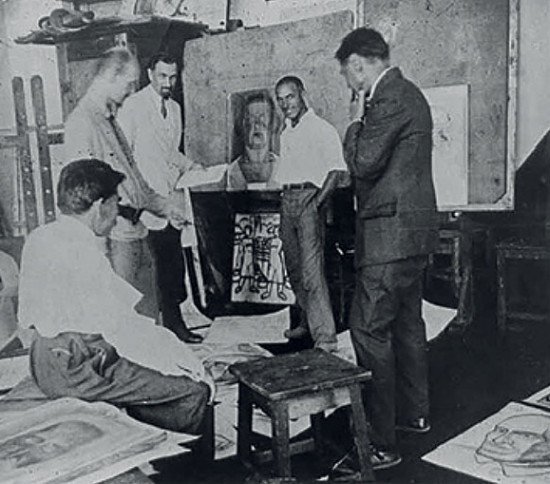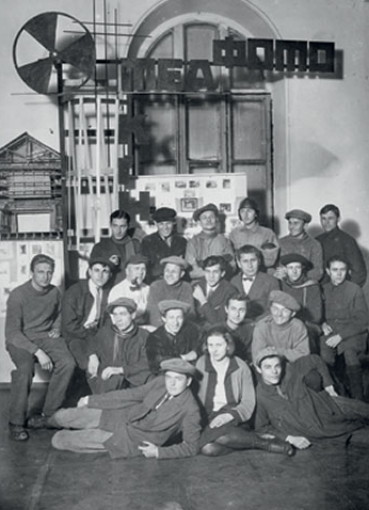National Academy of Fine Arts and Architecture
National Academy of Fine Arts and Architecture (Національна академія образотворчого мистецтва і архітектури; Natsionalna akademiia obrazotvorchoho mystetstva i arkhitektury). A higher educational institution that provides academic training in fine arts and architecture, including painting, drawing, graphic art, graphic design, sculpture, art conservation and restoration, stage design and film scenography, history and theory of art, and art management. It was formed in Kyiv in 1924 as Kyiv State Art Institute out of the Kyiv Institute of Plastic Arts, which in 1922 replaced the Ukrainian State Academy of Arts and Kyiv Architecture Institute (est 1918). Its forerunner, the Ukrainian State Academy of Arts, was founded at the initiative of the literary scholar Ivan M. Steshenko, then general secretary of education in the government of Ukrainian National Republic. Its inaugural ceremony took place on 5 December 1917 on the premises of the Central Rada, in the building of the former Pedagogical Museum (Teacher’s House). The academy was governed by a council composed of Dmytro Antonovych, Pavlo Zaitsev, Danylo Shcherbakivsky (scientific secretary), and others. The first rector was Fedir Krychevsky. The academy’s first professors included Mykhailo Boichuk (monumental painting), Mykola Burachek (landscape art), Vasyl H. Krychevsky (architecture, composition), Fedir Krychevsky (genre and historical painting, portraiture), Abram Manevych, Oleksander Murashko, and Mykhailo Zhuk (easel painting, drawing), Heorhii Narbut (graphic arts), and Danylo Shcherbakivsky (Ukrainian folk arts). They were joined in 1921 by Lev Kramarenko (monumental-decorative painting), Vadym Meller (stage design), Sofiia Nalepinska (engraving), Yevhen Sahaidachny and Bernard Kratko (sculpture), Andrii Taran (mosaics), and others. The academy was initially housed in the Pedagogical Museum, along with Central Rada, then it was transferred to the former Tereshchenko commercial school. In February 1919, after the second arrival of the Bolsheviks in Kyiv, the academy was granted a status of the state research institute. During a brief tenure of general Anton Denikin’s government, after his Volunteer Army captured Kyiv in August 1919, the academy was stripped of its status, denied funding, and expelled from its building. With the restoration of the Soviet government in December 1920 the academy was moved to the former building of the Noble Assembly (that stood on the site of today’s Trade Unions building on Khreshchatyk Street). In 1924, the newly created Kyiv Art Institute was housed in the building of the former Kyiv Theological Academy (academy’s present location), which was built in 1898 by Yevhen Yermakov.
In the 1920s the institute’s structure was significantly changed, reflecting the Bolshevik government’s preoccupation with the links between arts and industrial production. Consequently, the purpose of art education was redefined as ‘the harmonious formation of environment, everyday life, and production.’ New areas of study were added: theater, cinema, and photography (faculty of painting), carving and ceramics (faculty of sculpture), and new graphic technologies (faculty of printing art). The entire faculty of art pedagogy was opened to train art teachers and artists as ‘political educators.’ Several world-renowned artists were invited to teach at the institute, among them avant-garde painters Kazimir Malevich and Vladimir Tatlin. In the 1920s, the institute was one of the leading art schools in the Soviet Union, but by the end of the decade it was subjected to an increased ideological pressure. In 1930, several of its divisions were closed down, including the faculty of printing art; its rector Ivan Vrona was dismissed from his position. In the spirit of Stalinism, the institute was renamed as Kyiv Institute of Proletarian Art Culture and many of its programs necessary for training artists were replaced with highly ideological faculties, including that of art propaganda, art design of proletarian everyday life, sculpture design of socialist cities, and communist art education. A series of reforms in the 1930s restored in the institute academic methods of training. The easel art (that is, non-monumental and non-utilitarian art) became the basic element of training: by closely imitating life and nature in drawing and painting, each exercise requiring an increased level of skills, students prepared themselves for more specialized compositions in different areas of art. The Stalinist repressions severely disrupted art training in the institute and affected a number of its leading faculty members: several of them, including Mykhailo Boichuk, his wife Sofiia Nalepinska, and two of his former students (Vasyl Sedliar and Ivan Padalka) were executed; a few others were arrested and exiled (Bernard Kratko, Ivan Vrona, Onufrii Biziukov, Manuil Shekhtman, Hryhorii Dovzhenko, Kyrylo Hvozdyk).
During the Second World War the institute was evacuated to Samarkand, Uzbek SSR where its faculty members, among them Kostiantyn Yeleva, Lev Kramarenko, and Vasyl Kasiian created a number of historical and landscape paintings with Central Asian motifs. After the war, the institute added or restored several programs, including the faculty of graphic art (1948), with studios of book graphics, easel graphics, and political placards. The faculty of art pedagogy was added in 1958, followed by that of theory and history of art in 1959. The studios of monumental art and theater stage design were opened within the faculty of painting in 1965. Beginning with Nikita Khrushchev’s Thaw, a number of prominent Ukrainian artists taught at the institute, including Mykhailo Derehus, Tetiana Yablonska, Heorhii Yakutovych, Danylo Lider, and Vasyl Zabashta.
In 1992, the institute was renamed as the Ukrainian Academy of Arts, and in 1998 it assumed its current name. In 2000 it received a status of the national institution of higher learning in recognition of its achievements in the teaching and research of fine arts. The academy has four faculties: the faculty of fine arts and restoration with its chairs of painting and composition, graphic art, sculpture, graphic design, stage design and screen arts, and painting technique and restoration; the faculty of architecture with its chairs of architectural design, theory and history of architecture, and architectural construction; the faculty of theory and history of art which promotes art studies and research; and the faculty of general academic chairs, including drawing, culture, social sciences, the humanities, and foreign languages. It also has 17 art studios headed by prominent artists, art teachers, and scholars. In 2004 a branch of the academy was established in Kolchuhyne, Simferopol raion, in the Crimea (closed in 2014 due to the Russian annexation of the peninsula). Between 2018 and 2022, it operated an autonomous branch (Center for Art Education) in Mariupol that was severely damaged as a result of the Russian Federation’s invasion of Ukraine and was temporarily relocated to Kyiv. Its graduate program trains students in theory and history of arts and architecture. Its library has more than 177,000 documents, including a number of rare art books and periodicals. The academy enrols over 800 students.
Since 1922 the faculty has included such artists and scholars as Pavlo Aloshyn, Oleksander Verbytsky, Mykhailo Boichuk, Vasyl H. Krychevsky, Fedir Krychevsky, Vasyl Kasiian, Oleksii Shovkunenko, Serhii Hryhoriev, Anatol Petrytsky, Yevhen Sahaidachny, Mykhailo Lysenko, Hryhorii Svitlytsky, Ilarion Pleshchynsky, Tetiana Yablonska, Yurii Asieiev, Platon Biletsky, and Liudmyla Miliaieva. Its rectors (directors) have been Fedir Krychevsky (1917–18 and 1920–22), Heorhii Narbut (1918–20), Lev Kramarenko (1922–24), Ivan Vrona (1924–30), Serhii Tomakh (1930–34), Bernard Kratko (1934), Arkadii Benkovych (1934–38), Serhii Tkachenko (1938–40), Illia Shtilman (1940–44), Mykhailo Sharonov (1944–51), Serhii Hryhoriev (1951–55), Oleksandr S. Pashchenko (1955–63), Oleksii Oliinyk (1963–65), Vasyl Borodai (1965–73), Oleksandr Lopukhov (1973–85), Valentyn Borysenko (1985–88), Andrii Chebykin (1989–2020), Ostap Kovalchuk (2020–21), and Oleksandr Tsuhorka (2021–). The academy publishes periodical compendium Ukraїns'ka akademiia mystetstva (31 vols, 1994–).
BIBLIOGRAPHY
Pavlovs'kyi, V., ‘Ukraїns'ka Derzhavna Akademiia Mystetstv do 50-littia ii stvorennia,’ Notatky z mystetstva/Ukrainian Art Digest 7 (Philadelphia 1968)
Kashuba-Vol'vach, O., Ukraїns'ka akademiia mystetstva. Vol. 1. Istoriia zasnuvannia (berezen'-hruden' 1917). Khronolohiia podii. Dokumenty (Kyiv 2014)
Ukraїns'ka akademiia mystetstv: istoriia zasnuvannia ta fundatory (Kyiv 2015)
Academy’s official website: https://naoma.edu.ua/
Serhiy Bilenky
[This entry was written in 2023.]



.jpg)